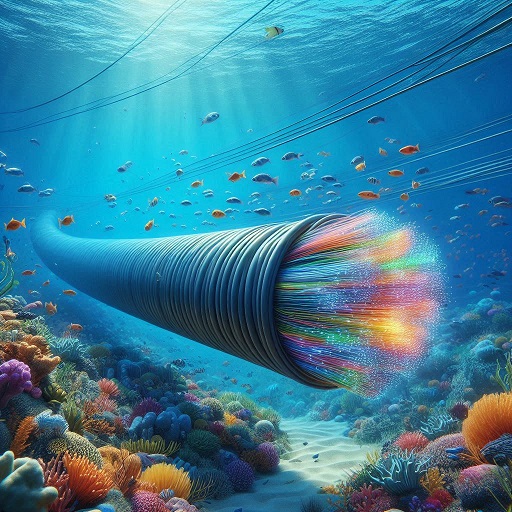Submarine cable systems have evolved into a crucial component of modern infrastructure, connecting continents and facilitating a seamless exchange of information, power, and data worldwide. These undersea cables, often stretching across oceans and seas, are responsible for transmitting an estimated 95% of global internet traffic, underscoring their vital role in global communications and connectivity.
Submarine cable systems are underwater networks of cables laid on the ocean floor, designed to transmit telecommunication signals, electrical power, or other forms of data. These cables consist of several layers, including insulation, shielding, and protective coatings, enabling them to endure the harsh conditions of the deep sea.

Submarine Cable System Market Growth Outlook
Types of Submarine Cable Systems
Fiber Optic Submarine Cables
Fiber optic submarine cables form the backbone of global internet connectivity. By transmitting data using light signals, they allow for high-speed communication across continents, supporting everything from online browsing to large-scale cloud services.
Power Cables
Submarine power cables are used for transmitting electrical power across bodies of water. These are particularly vital for connecting offshore wind farms to onshore power grids, helping to harness renewable energy sources.
Telecommunications Cables
Telecommunication cables enable long-distance phone calls, internet services, and the interconnection of communication networks globally. They serve as a bridge between different continents, facilitating international communication and commerce.
Key Components of Submarine Cable Systems
Cable Types and Materials
Modern submarine cables are constructed with durable materials, including polyethylene, copper, and fiber optics, to ensure reliable transmission and longevity underwater.
Repeaters and Amplifiers
To maintain signal strength over vast distances, repeaters and amplifiers are strategically placed along the length of submarine cables. These devices boost the signals, ensuring uninterrupted communication between continents.
Landing Stations
Landing stations are critical points where submarine cables meet the terrestrial network. These stations serve as the link between the undersea cable and the local telecommunications infrastructure, enabling the transmission of data to end-users.
Primary Applications of Submarine Cable Systems
Global Telecommunications
Submarine cables are the foundation of the global telecommunication network, connecting nations and enabling the rapid exchange of data, voice, and video services.
Internet Connectivity Infrastructure
The global internet relies heavily on submarine cable systems for fast and reliable connectivity. These cables support international data transfer, ensuring seamless internet access for billions of users worldwide.
Data Transmission and Streaming
Submarine cable systems facilitate high-speed data transmission essential for video streaming, online gaming, and other digital services that require large amounts of bandwidth.
Role in International Communications
Connecting Continents and Nations
Submarine cables provide the physical connection between continents, supporting not only internet services but also international calls, business transactions, and cloud services that operate on a global scale.
Impact on Global Connectivity
Without submarine cables, the global digital infrastructure would be vastly limited. These systems allow for instantaneous communication across borders, enabling the rapid growth of digital economies and international trade.
Role in Energy Distribution
Submarine Power Cables for Renewable Energy
Submarine power cables play a crucial role in the development of offshore wind farms and other renewable energy projects. These cables transmit electricity generated offshore to onshore grids, supporting the transition to cleaner energy sources.
Transmission of Power Between Regions
Submarine power cables are also used to transmit electricity between regions and countries, particularly in areas separated by bodies of water. This interconnection allows for more efficient energy distribution and utilization.
Submarine Cables in Scientific Research
Environmental Monitoring
Submarine cables equipped with sensors are used for environmental monitoring, providing valuable data on ocean temperatures, seismic activity, and underwater ecosystems.
Oceanographic Data Collection
Submarine cable systems are essential tools in oceanographic research, enabling scientists to gather data on deep-sea environments and monitor changes in the ocean over time.
FAQs
- What are submarine cable systems used for?
Submarine cable systems are primarily used for transmitting data, telecommunication signals, and electrical power across oceans and seas. They support global internet connectivity, international phone calls, and renewable energy distribution. - How do submarine cables work?
Submarine cables work by transmitting signals via fiber optic strands for telecommunications or power through electrical cables. Repeaters are placed along the cable to boost signals over long distances, ensuring effective transmission across continents. - Why are submarine cables important for the internet?
Submarine cables are critical for internet connectivity as they carry 95% of global data traffic. Without these cables, high-speed data transmission between countries and continents would not be possible, limiting global communication and digital services. - How are submarine cables laid on the ocean floor?
Submarine cables are laid using specialized ships that carefully deploy the cables along the seabed. The cables are designed to withstand deep-sea conditions and are strategically positioned to avoid damage from marine activities. - What are the environmental impacts of submarine cables?
While submarine cables can affect marine ecosystems during installation, the long-term impact is generally minimal. Efforts are made to mitigate environmental disruption by following guidelines and utilizing technologies that reduce harm to marine life. - What are the future trends in submarine cable technology?
Future trends in submarine cable technology include advancements in fiber optic cables to increase data capacity, more secure systems to prevent interference, and expanded use in supporting 5G networks and renewable energy transmission.
